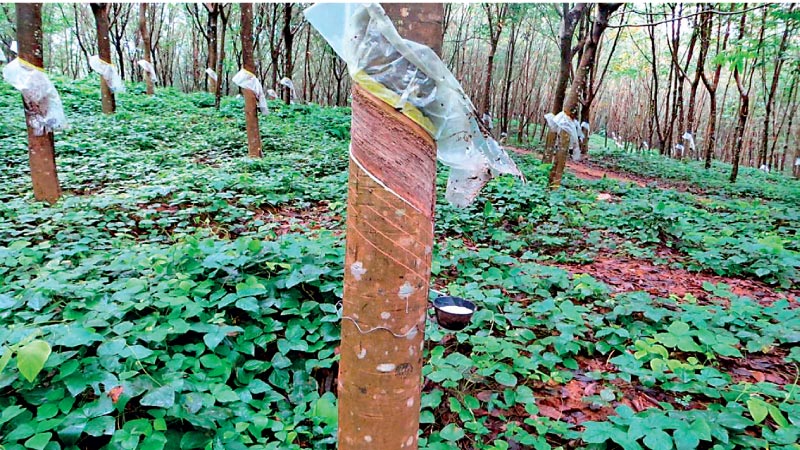Thursday Jan 01, 2026
Thursday Jan 01, 2026
Thursday, 3 March 2022 02:04 - - {{hitsCtrl.values.hits}}

By The Colombo Rubber Traders’ Association
When Henry Wickham smuggled out a few natural rubber seeds from the Amazon forest, Brazil in 1876 and planted them in Henerathgoda, Gampaha nobody would have dreamt by any dint of imagination that this tiny rubber plant would make giant strides in the spheres of the economic and industrial revolution across the world.
Today, Henarathgoda garden is known as the cradle of the global natural rubber industry. Over 95% of the natural rubber supply to the world is produced in plantations in Southeast Asia while the balance 5% is produced in African countries.
While the total crop harvested from an acre of rubber was as low as 45 lbs (20 Kg) at the industry’s inception, plant breeders have since been able to breed high yielding clones and develop efficient latex extraction techniques to increase land productivity from 2,500 to 3,000 Kg of dry rubber per hectare per year.
Over and above this, the NR tree provides a supply of 40 to 50 Kg of valuable timber suitable for furniture manufacture while the branches and the rootstock of the tapped-out old tree provide firewood for domestic cooking and for bread, lime, and brick kilns. Both these industrial raw materials are made from the rubber tree by converting CO2 gas in the atmosphere without consuming any of the nutrients added as fertiliser.
During the process of making NR hydrocarbon in latex form in the tree and wood, NR plantations sequestrate nearly 10 Mt of Carbon Dioxide (CO2 ) gas per hectare per year if the stand is maintained at 475 to 500 trees
per hectare.
It is a well-established fact that the main reason for global warming, commonly known as the Greenhouse effect, is due mainly to the increase in CO2 levels in the atmosphere. With industrialisation, CO2 levels in the atmosphere, which were only about 220 parts per million in the 1960s have doubled to over 440 ppm in 2020.
It is this increased level of CO2 gas in the atmosphere absorbing heat radiation from the sun that is causing global warming, thereby increasing the water level in the sea and submerging cities such as Singapore as well as other major cities in USA and Europe, below the mean sea level.
Carbon dioxide is the only Greenhouse gas which can be removed by the simple and useful method of growing trees, while other Greenhouse gases such as Methane and Oxides of Nitrogen cannot be removed so easily. Hence, it is obvious that it is this nearly 15 million hectares of rubber plantations across the whole world that deliver these environmental benefits to mankind.
In addition, it is a well-known fact that the harvest of agricultural crops across the world will be significantly reduced by the Greenhouse effect while the population of sea creatures such as jellyfish would increase and the population of fish with vertebra would be reduced significantly. This is due to the acidification of seawater caused by the dissolution of increasing levels of CO2 released to the atmosphere thereby preventing the ability of sea creatures to fix Calcium as Calcium carbonate in bones and shells.
From these scientific revelations, growing Natural Rubber is not only beneficial from the industrial point of view, but also as a crop providing the important benefit of repairing the damage caused to the environment by the ever-increasing level of CO2 gas in the atmosphere due to burning fuels and biomass.
Hence, it could be cogently argued that the diversification of rubber lands to alternate crops by farmers is highly counterproductive to our environment.
By 1970, the total rubber extent in Sri Lanka was around 230000 acres, of which smallholders having less than 20 acres were responsible for nearly 65%. Today, the extent has declined to just over 125000 acres while the total rubber production too has declined from 165000 Mt produced in the mid-1960’s to less than 80,000 Mt last year. The main reason for this was the poor prices prevailing in the world market for about a decade.
However, the extent of rubber in other countries in Asia and Africa has been on increase.
Performance of the rubber estates under private management has declined though expectations were otherwise. The total extent of rubber under RPCC has been declining constantly at a rate of about 1.5% annually since the privatisation of the estates.
Productivity of rubber has also declined at a rate of 0.2% annually since privatisation to a value as low as 750 Kg/Ha/Yr. Over 46% labour wage increases during this 20 year period have made the situation worse for the private management companies.
Even the performance of smallholdings during this period has been negatively impacted by the poor price of rubber and the ever-increasing labour wages recording productivity below the productivity of RPCC from about the last couple of years, whereas it has always been higher than the estate figure throughout the past two decades.